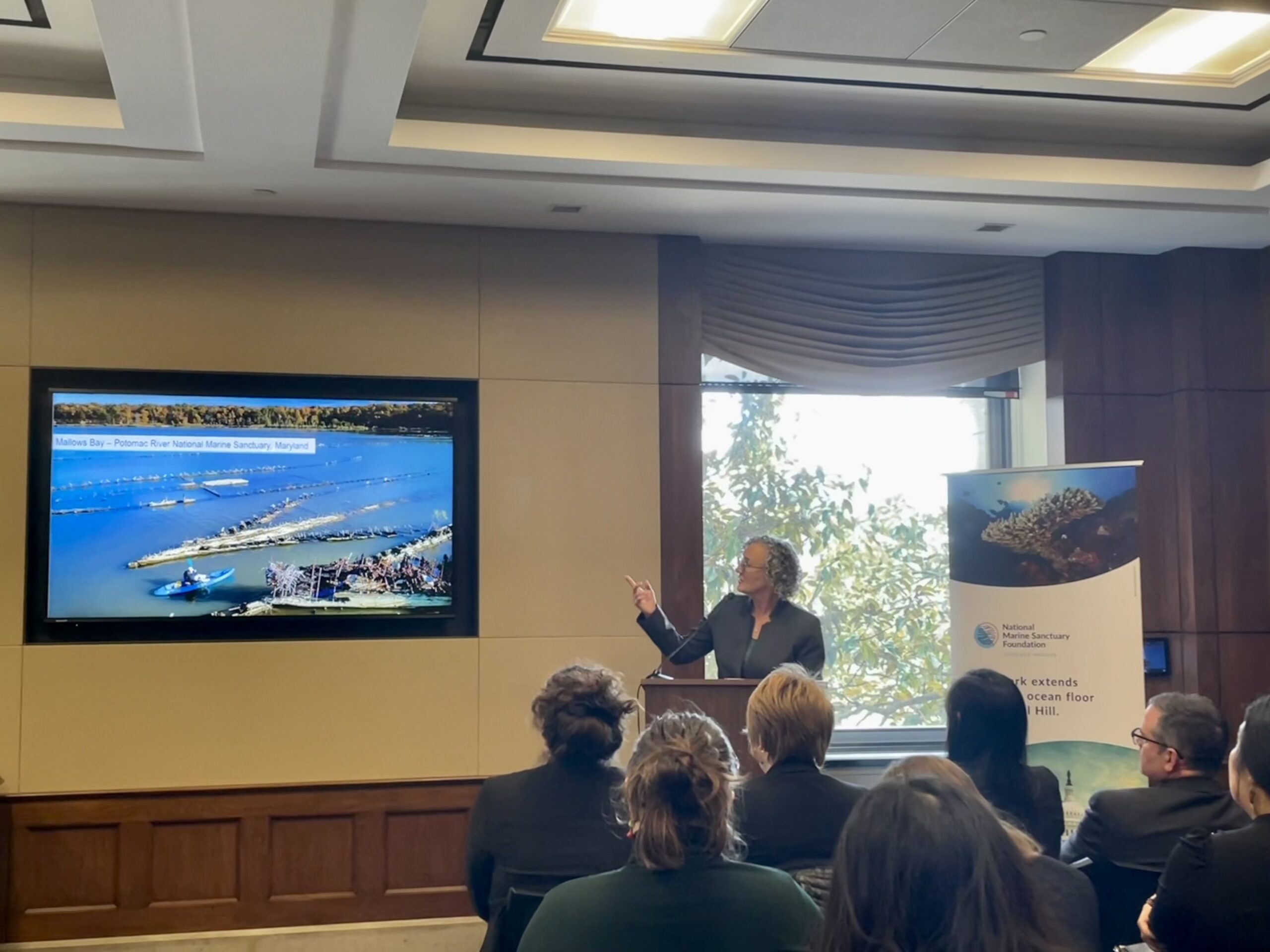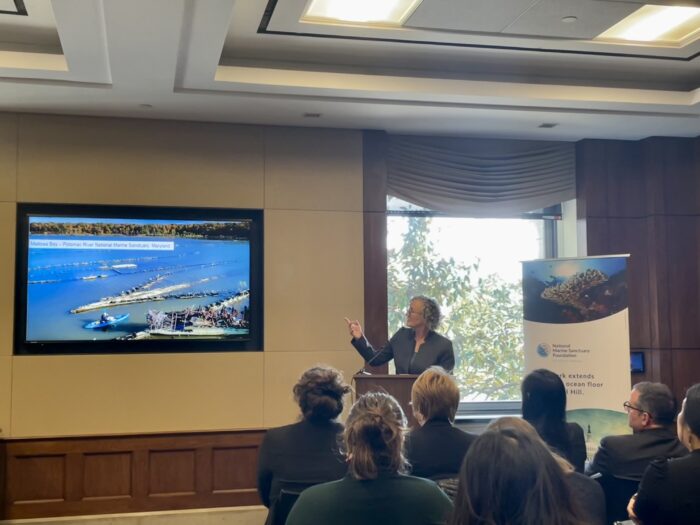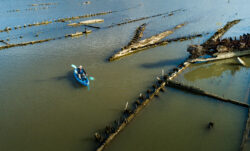
Community Leaders Speak on Sanctuary Impacts and Value on Capitol Hill

Photo credit: Jenny Larsen
By Eileen Abel, Sanctuary Advisory Council Chair for Mallows Bay-Potomac River National Marine Sanctuary
March 1st in Washington, DC, offered what some call mixed messages weather: sunny skies and almost moderate spring temperatures, but enough brisk wind to remind those of us brave enough to be lunching outdoors that Old North Wind hadn’t given up his bid to keep winter’s chill around just a little longer. Of the group having lunch on the café’s patio, two of us were out-of-towners: Bill Crist from Syracuse, NY, and I, from Charles County, Md, but we were all united in the shared and exciting enterprise of the day. The National Marine Sanctuary Foundation staff, who comprised the remainder of the lunch group along with representatives from NOAA’s Office of National Marine Sanctuaries, had invited Bill and me to present to the bi-partisan Congressional National Marine Sanctuary Caucus that afternoon, an invitation we both accepted immediately when asked, so passionate are we about this work. A lunch together first was an added bonus, and yes, we all ordered hot food.
Bill is the Sanctuary Advisory Council (SAC) Chair for the proposed Lake Ontario National Marine Sanctuary in New York State, and I am the SAC Chair for Mallows Bay-Potomac River National Marine Sanctuary (or more colloquially just “Mallows Bay”) in Charles County, Maryland, designated in 2019. Both Lake Ontario and Mallows Bay were part of the sanctuary nomination process, which means local leaders, Indigenous communities, and residents from nearby communities gathered together to petition for designation, believing their communities would benefit living next door to a national marine sanctuary.

Photo credit: National Aquarium
We have a national-level brand in our sanctuary system, and Mallows Bay being so close to the nation’s capital gives it additional stature to catalyze interest in America’s protected areas and to spur technology, science, and economic development in the area. We call Mallows Bay “the Capital’s sanctuary”—or DC’s sanctuary away from the everyday— and it is, after all, only 42 miles down the road from the very place we presented in the Rayburn House Office Building that chilly March day to a few dozen interested Congressional staffers.
This was the first Congressional National Marine Sanctuary Caucus briefing held in-person on Capitol Hill since the Caucus was re-launched in 2021 to kick off the year-long celebration of the 50th anniversary of the National Marine Sanctuary System. The Caucus is a bipartisan coalition of champions in Congress dedicated to increasing awareness of and strengthening commitment to America’s national marine sanctuaries. Its membership serves as a strong voice to raise awareness of sanctuaries and prioritize sanctuary issues on behalf of communities and our nation. These Members recognize the value of sanctuaries as models for marine conservation worldwide—promoting ocean health, honoring heritage, bolstering local economies and jobs, supporting public access to recreation, and advancing education and community-building.
Upstream decisions have downstream consequences (something our western neighbors know too well, with the consequences of a drained Colorado River Basin). This is true in an ecological sense, as the impacts of activities and pollutants higher in our rivers and streams flow down and influence distant parts of the watershed. The waters of the Potomac River and the Chesapeake Bay can threaten the ecology and the very “ghost ships” themselves in the Mallows Bay basin, due to carrying warming water downstream with increasingly higher levels of pollution and salinity.
But this also applies to how the “upstream” decisions made at our highest levels of government by policymakers and elected officials have a ripple effect that trickles down from Capitol Hill to our sanctuaries (like Mallows Bay located literally downstream from our nation’s capital) and the local communities that depend on and benefit from them. Congressional support from champions like those in the National Marine Sanctuary Caucus makes the essential education, outreach, research, and conservation programs conducted by sanctuary site and local leaders possible. In turn, our sanctuaries help local communities to thrive through environmental and economic benefits like recreation, tourism, and job creation and protecting precious heritage resources for future generations to enjoy.

Photo credit: Matt McIntosh/NOAA
Mallows Bay National Marine Sanctuary, home of the “Ghost Fleet,” is also a driver for recreation, community development, science education and research in the surrounding area. It is also a place of history, culture, and imagination. In an era where large portions of the Earth’s surface are being ravaged by development, when new science tells us that ecosystems are interconnected in ways we could never have fathomed in the past, and when philosophers tell us that geography contributes fundamentally to personal and social identities, sanctuaries—like other protected places across the United States—carry multiple meanings for the communities they serve and the communities in which they are embedded.
Mario Harley, the Piscataway Indian tribe representative on our SAC, links the geography of Mallows Bay directly to the larger Piscataway world view:
“Within the area on the Potomac River now designated as the Mallows Bay National Marine Sanctuary we, the Piscataway Indian people, teach our next generation the lesson that “We are all Connected”. Every year in the western mountains, heavy winter snow falls eventually become the source of the spring melt. This annual thaw replenishes the headwaters of the Potomac River, which then refills the sacred fresh waters within the Mallows Bay National Marine Sanctuary. Every fall, Atlantic Ocean hurricanes and Nor’easters push saltwater into the Chesapeake Bay and thus into the Potomac River. When fresh river water meets brackish water, the lighter fresh water rises and moves over the denser salt water. In our Piscataway language we identify this area as Pasicipexux – (Pah-C-Chee Pay Kook) which means “Where the Freshwater Flows Over”. This water blending area occurs within the Mallows Bay National Marine Sanctuary and is unique within the 400-mile-long Potomac River. Our planet’s water is a sacred gift that much too often is taken for granted. Pasicipexux (Pah-C-Chee Pay Kook) is a physical reminder that what happens 100s of miles away from us in every direction can have a direct impact here. Thus, we teach our next generation to be thoughtful when making decisions. The decisions that we, as two-leggeds make here within our homelands may have impacts to others that are hundreds of miles away. We are all connected!”
Because not everyone lives nearby, and not everyone can , these technologies make Mallows Bay accessible to anyone, anywhere.
When people visit Mallows Bay, geting in a kayak or a canoe to experience the ghost ships or walking the lovely trails through the hills above, magic happens. But Mallows Bay also serves as a living laboratory for science education and research from elementary through graduate school. Let me share three examples.
Graduate students in Coastal Sciences from East Carolina University (ECU) are studying the microbiomes of both metal and wooden-hulled vessels to aid not only in the future management of these resources, but also to contribute to the worldwide UN Decade of Ocean Science for Sustainable Development efforts, to study the impacts of climate change on vessels in various environments. Students have produced 3-D imagery of several of the vessels, which are useful both for academic study but also to make them available globally online.
Additionally, local teachers have taken their science classes there for years. Many students have never canoed before, or done water quality testing, or studied wildlife, or were aware of native plants like wild rice or pawpaw that grow in the area.

Photo credit: Eileen Abel
One elementary school teacher brings 125 kids to Mallows every year. These 4th graders could choose from a variety of activities based on the natural, historic, and environmental aspects of Mallows Bay, including bird watching, fishing, seining, buoy building, hiking, water testing, analyzing macroinvertebrates, and soil testing. One student was so profoundly influenced by her experiences she wrote to her teacher many years later and expressed her gratitude for having had a teacher who instilled in her a love of science that “prepared me for life and for the future without even knowing and I am so thankful”; another testified at a public hearing on the importance of sustaining a clean watershed, and specifically called out her experience at Mallows Bay.
This picture was drawn by a 4th grader: it is a shot of the experiment station from above showing the tables, laden with specimen-filled ice cube trays and a supply box, with nets nearby, and of course, the stated desire to one day teach.
Mallows Bay helps inform our present generation and inspire the next. As the Piscataway teach us: We are all connected!
What a treasure we have in the National Marine Sanctuary System, and what an honor to be part of the community and national support that buoys these unique and precious areas.
